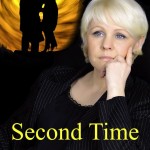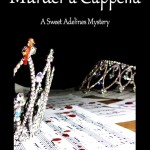Today, I’m interviewing Holli Castillo, whose background runs from competing as a gymnast at the 1984 New Orleans World’s Fair, to working in many positions in theatrical productions, including performing as a Can Can girl. After she received her JD from Loyola University, she joined the Orleans Parish District Attorney’s office. She quit the D.A.’s office when she had her first child, and is now an appellate public defender. Sounds interesting to me.
competing as a gymnast at the 1984 New Orleans World’s Fair, to working in many positions in theatrical productions, including performing as a Can Can girl. After she received her JD from Loyola University, she joined the Orleans Parish District Attorney’s office. She quit the D.A.’s office when she had her first child, and is now an appellate public defender. Sounds interesting to me.
Jim: How was it going from the DA’s office to public defender? Aren’t those on opposite sides of the aisle?
Holli: They are the opposite sides, but the knowledge and skill translate well from one to the other. The D.A.’s job is supposed to be to present the truth and let the jury make a determination of whether the defendant is guilty or not. The defense’s job is to make sure that no one cheats in getting a conviction. That isn’t the way it usually works out. Having done both, I can say both sides have the exact same goal–to win at any cost. It’s not really so different in the end, and the law is the law.
Jim: At what stage did you decide to write?
Holli: I have been writing stories since I was in Kindergarten and novels since I was in 6th grade. I didn’t decide to try to write something for publication until I quit the D.A.’s Office to stay home with my first child in 2000.
Jim: 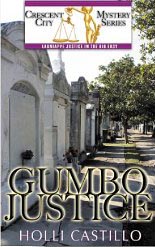 And how long did it take you from when you first started writing until Gumbo Justice appeared in 2009?
And how long did it take you from when you first started writing until Gumbo Justice appeared in 2009?
Holli: It took about 4 years to write the novel. But then Katrina hit in 2005 and in June of 2008 I was in a head-on collision with a drunk driver and was on my back for a year. So it actually took 9 years, but only 4 of that was writing.
Jim: As with most of us, some personal history influences what gets written. How did your experience in the District Attorney’s office color your novels?
Holli: Nearly all of my ideas are sparked by real cases I’ve handled, either as a D.A. or a defense attorney. The D.A.’s Office definitely gave me the inside track on how a prosecutor’s office works, especially the office dynamics and criminal procedure. I can include all aspects of criminal prosecution in my novels. My protag knows how to do everything I know how to do, she knows the same lingo, she knows how to cheat, etc. 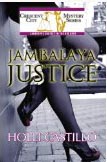
Jim: Jambalaya Justice won an award before it was published. Tell us just a little about that.
Holli: I entered it in the PSWA contest for unpublished fiction and it tied for first place.
Jim: And the third in this Crescent City Mystery Series is called Chocolate City Justice. First, I have to ask, is New Orleans known as the Chocolate City? I’ve never heard that term applied to New Orleans.
Holli: The title comes from a speech our mayor made on the first Martin Luther King Day following Katrina. He gave a grandiose speech about how at the end of the day, New Orleans would be a Chocolate City again, referring to the fact that more white people were returning to the city than black people. It caused quite a stir.
Jim: Well, I’ve learned something new today. That’s good. Tell us a little about Chocolate City Justice.
Holli: Ryan has just been assigned a real plum by prosecutor standards, a child’s birthday party massacre caught on videotape. But as most things in New Orleans, nothing is what it seems and the case starts to turn into a nightmare. And then along comes Katrina. Ryan plans to evacuate, but does an unexpected favor for a friend, causing her to miss her window to escape the storm, ultimately putting her on the radar of the gang she’s prosecuting for the birthday party shooting. But Ryan isn’t worried. She’s handled some of the worst criminals the city has to offer, and hurricanes never hit New Orleans. Right?
Jim: And when will that be available?
Holli: We’re still working on a release date, but I can safely say this year, sometime in 2014.
Jim: And lastly, where is the best place for us to buy your books?
Holli: They are on Amazon, Barnes and Noble, and my publisher’s website, www.oaktreebooks.com
Thanks so much for having me!
Jim: It was my pleasure, Holli.


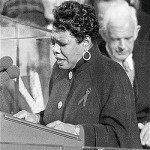
 Our guest post today comes from Lesley Diehl, a retired professor of psychology. She splits her time between upstate New York where she and her husband are renovating an 1872, ghost-inhabited cottage, and old Florida where spurs still jingle in the post office and gators make golf a contact sport. Today, she asks the question, Bury that manuscript in a drawer or rewrite it?
Our guest post today comes from Lesley Diehl, a retired professor of psychology. She splits her time between upstate New York where she and her husband are renovating an 1872, ghost-inhabited cottage, and old Florida where spurs still jingle in the post office and gators make golf a contact sport. Today, she asks the question, Bury that manuscript in a drawer or rewrite it?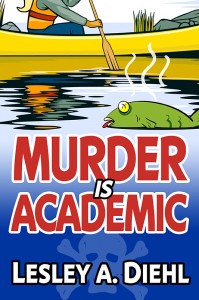
 competing as a gymnast at the 1984 New Orleans World’s Fair, to working in many positions in theatrical productions, including performing as a Can Can girl. After she received her JD from Loyola University, she joined the Orleans Parish District Attorney’s office. She quit the D.A.’s office when she had her first child, and is now an appellate public defender. Sounds interesting to me.
competing as a gymnast at the 1984 New Orleans World’s Fair, to working in many positions in theatrical productions, including performing as a Can Can girl. After she received her JD from Loyola University, she joined the Orleans Parish District Attorney’s office. She quit the D.A.’s office when she had her first child, and is now an appellate public defender. Sounds interesting to me.

